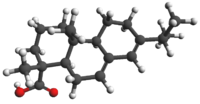Loading AI tools
Chemical compound From Wikipedia, the free encyclopedia
Abietic acid (also known as abietinic acid or sylvic acid) is a mild organic acid found in coniferous trees.
 | |
 | |
| Names | |
|---|---|
| IUPAC name
Abieta-7,13-dien-18-oic acid | |
| Systematic IUPAC name
(1R,4aR,4bR,10aR)-1,4a-Dimethyl-7-(propan-2-yl)-1,2,3,4,4a,4b,5,6,10,10a-decahydrophenanthrene-1-carboxylic acid | |
| Other names
Abietinic acid; Sylvic acid | |
| Identifiers | |
3D model (JSmol) |
|
| ChEBI | |
| ChEMBL | |
| ChemSpider | |
| ECHA InfoCard | 100.007.436 |
| EC Number |
|
| KEGG | |
PubChem CID |
|
| RTECS number |
|
| UNII | |
CompTox Dashboard (EPA) |
|
| |
| |
| Properties | |
| C20H30O2 | |
| Molar mass | 302.458 g·mol−1 |
| Appearance | Yellow resinous powder, crystals or chunks. Monoclinic plates (from EtOH/water). Colorless solid when pure. |
| Density | 1.06 g/mL |
| Melting point | 172–175 °C (342–347 °F; 445–448 K)[1] |
| Boiling point | 250 °C; 482 °F; 523 K |
| Insoluble[1] | |
| Solubility in other solvents | Very soluble in acetone, petroleum ether, Et2O, and ethanol |
| Hazards | |
| Occupational safety and health (OHS/OSH): | |
Main hazards |
Irritant |
| GHS labelling: | |
 | |
| Warning | |
| H317 | |
| P261, P272, P280, P302+P352, P321, P333+P313, P363, P501 | |
| NFPA 704 (fire diamond) | |
| Safety data sheet (SDS) | MSDS |
Except where otherwise noted, data are given for materials in their standard state (at 25 °C [77 °F], 100 kPa).
| |
It is a commercially important component of paints, soaps, foods, and soldering flux, and is the primary component of resin acid.
Abietic acid is found in pine trees, including:
Pure abietic acid is a colorless solid, but commercial samples are usually a glassy or partly crystalline yellowish solid that melts at temperatures as low as 85 °C (185 °F).[3]
Abietic acid is soluble in alcohols, acetone, and ethers. Its ester or salt is called an abietate.[4]
Abietic acid belongs to the abietane diterpene group of organic compounds derived from four isoprene units.
Abietic acid is extracted from tree rosin[5] (via isomerization) and is the most abundant of several closely related organic acids that constitute most of rosin, the solid portion of the oleoresin of coniferous trees.
Resin acids are converted into ester gum by reaction with controlled amounts of glycerol or other polyhydric alcohols.
Abietic acid has drying properties, and as ester gum is used in paints, varnishes, and lacquers.[3]
It is also used in soaps, for the analysis of resins, and the preparation of metal resinates.
Rosin, of which abietic acid is the principal component:
Seamless Wikipedia browsing. On steroids.
Every time you click a link to Wikipedia, Wiktionary or Wikiquote in your browser's search results, it will show the modern Wikiwand interface.
Wikiwand extension is a five stars, simple, with minimum permission required to keep your browsing private, safe and transparent.